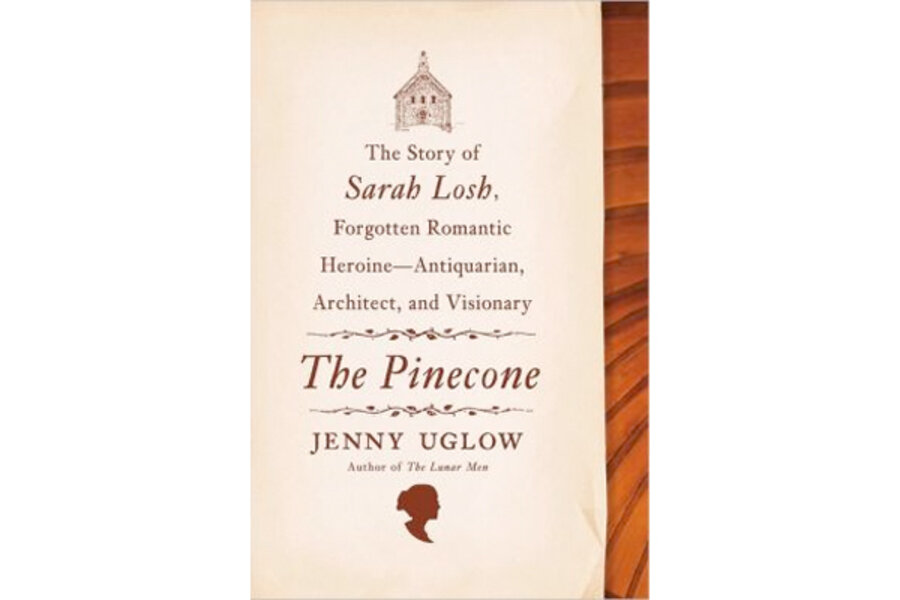The Pinecone
Loading...
Writing history is a challenge beset with pitfalls for the writer. Characters and context vie for center stage. Too much emphasis on characters that shape history, and you've got one foot in Hollywood, the other on a banana peel. Too much context, and the authorial ego fills the vacuum with homemade narrative, trumped-up theories, and sleep-inducing detail (years of lonely, dedicated research). It's an awful lot to ask for both.
But if you love history, if you are a reader who looks to history to understand the present, you understand the thrill of the terms "Forgotten Romantic Heroine" and "Visionary." And you look for the work of writers like Jenny Uglow, who navigates past the temptations and traps of historical narrative with grace in The Pinecone.
Uglow first saw the magical church that Sarah Losh created in 1842 when she was a girl growing up in Cumbria. There it must have sat, as it has sat in the village of Wreay, near Carlisle, in Jenny Uglow's mind, as she layered prizewinning biographies of Elizabeth Gaskell, William Hogarth, the engraver Thomas Bewick, and Henry Fielding (and even A Little History of British Gardening) upon it. But how could she write about Sarah Losh – a profoundly educated woman growing up in Regency England, fascinated by the natural history of her own backyard, the medieval history buried in the stones of her family home in Wreay, and the larger world of mathematics, physics, philosophy, biology, geology, art, etc., etc. – before she (Uglow) had lived and studied and made a name for herself in her own chosen field?
Why is the timing of this book in the writer's career so interesting? Because the book explains so much. About how the little things around us, the things that fascinate us as children, the shapes and colors of our own backyards inform the mark we will make on the world. About the swirl of characters in the late eighteenth century and early nineteenth cross-pollinated to move art and science forward. About women, property, struggle, and ease. About symbolism and nature; religion and power.
The family of Uglow's heroine were landowners and merchants (much of their fortune was made in ash, or soda). Her father and uncles were radicals, defenders of the poor, believers in the rightness of agrarian life but excited about the future – the mills and factories and railroads that would transform their towns and landscapes. They travelled to learn the latest in mathematics, chemistry, and physics straight from the horse's mouth -- they counted among their friends William Wordsworth, William Paley, Joseph Priestly, John Dawson, William Turner, John Curwen – some names you may know, some you may vaguely recognize. The Regency conversation drew broadly on the past – what to abandon and what to cherish? Mystery, magic, druids, Celtic saints, Greek gods. Even as the poor began their long march into lives of overwhelming, unsustainable drabness, those who could afford to looked forward and back.
Sarah Losh, born in 1786, and her beloved sister, Katharine, chose not to marry. They were tutored in a broad variety of subjects; read the works of Byron, Scott, and Mary Wollestonecraft; believed in the education of women and were not challenged or thwarted in their interests, at least at home. Sarah took an interest in building (the architectural critic Simon Jenkins later called her "a Charlotte Brontë in wood and stone"). She learned how to carve from local artisans; she made the Great Tour, taking copious notes (though her journals have yet to be discovered!) on art and architecture. She was a keen naturalist, and the symbols on her buildings include oak leaves, wheat, butterflies, pomegranates, winged turtles, bees, ravens, scarabs, fir branches, fossils, and owls. The pinecone rose to the top of Losh's natural theology as her signature symbol of regeneration, the mathematical certainty of a future (like the nautilus, a natural example of the Fibonacci sequence, without end). When her old family friend William Thain was killed fighting in Afghanistan in 1842, she planted, in front of the church at Wreay, a Khelat pine seed from the pinecone he sent her before his death.
After their mother and then, fourteen years later, their father died, the sisters ran their own home and their considerable holdings. Like their father and uncles, they were pillars of their community, funding and building a chapel and then a school. The sisters traveled, and then, in 1835, Katharine died; Sarah was bereft. She threw herself into building the famous church of Wreay. Constructed at a time when Gothic cathedrals were defending the honor of the rapidly weakening Anglican Church, Losh's church was Norman, early Christian, Romanesque, pantheistic, classical. She carved the font and the candlesticks herself. In nearby Carlisle and Newcastle, the factories belched and the mills and mines took lives.
Let it be known that I am a fan of Jenny Uglow. I share her belief that land is the basis for history and nature is the fountain, the source of culture. After years of struggling with British literature (taught, in my day, as though Americans were just learning to read and write in the twentieth century), I finally understand how fundamental land, specifically the ownership of land, was and is to the British character, a driving force in politics and culture, an obsession, leading in its mildest (but still competitive form) to gardening.
Uglow builds Losh from the ground up, so to speak. Once her subject, who died in 1853, is fixed in your mind, you will look at pinecones quite differently – their sturdy promise, their rich complexity – and you may think that you will begin to read more in the evenings, maybe study a language, entertain a childhood dream, leave something enigmatic behind when you finally, gracefully, slip away.
Susan Salter Reynolds is a writer and book critic. She is a regular contributor to the Los Angeles Times.








